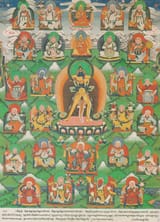Search Results
!!P38zFLDUYUh/x/40730419#40730699
7/15/2025, 9:26:52 PM
>>40730682
To elevate his authority beyond worldly challenge, the first Dalai Lama seized monasteries that did not belong to his sect, and is believed to have destroyed Buddhist writings that conflicted with his claim to divinity. The Dalai Lama who succeeded him pursued a sybaritic life, enjoying many mistresses, partying with friends, writing erotic poetry, and acting in other ways that might seem unfitting for an incarnate deity. For this he was “disappeared” by his priests. Within 170 years, despite their recognized status as gods, five Dalai Lamas were murdered by their enlightened nonviolent Buddhist courtiers.
Shangri-La (for Lords and Lamas)
Religions have had a close relationship not only to violence but to economic exploitation. Indeed, it is often the economic exploitation that necessitates the violence. Such was the case with the Tibetan theocracy. Until 1959, when the Dalai Lama last presided over Tibet, most of the arable land was still organized into religious or secular manorial estates worked by serfs. Even a writer like Pradyumna Karan, sympathetic to the old order, admits that “a great deal of real estate belonged to the monasteries, and most of them amassed great riches … In addition, individual monks and lamas were able to accumulate great wealth through active participation in trade, commerce, and money lending.” Drepung monastery was one of the biggest landowners in the world, with its 185 manors, 25,000 serfs, 300 great pastures, and 16,000 herdsmen. The wealth of the monasteries went to the higher-ranking lamas, many of them scions of aristocratic families, while most of the lower clergy were as poor as the peasant class from which they sprang. This class-determined economic inequality within the Tibetan clergy closely parallels that of the Christian clergy in medieval Europe.
To elevate his authority beyond worldly challenge, the first Dalai Lama seized monasteries that did not belong to his sect, and is believed to have destroyed Buddhist writings that conflicted with his claim to divinity. The Dalai Lama who succeeded him pursued a sybaritic life, enjoying many mistresses, partying with friends, writing erotic poetry, and acting in other ways that might seem unfitting for an incarnate deity. For this he was “disappeared” by his priests. Within 170 years, despite their recognized status as gods, five Dalai Lamas were murdered by their enlightened nonviolent Buddhist courtiers.
Shangri-La (for Lords and Lamas)
Religions have had a close relationship not only to violence but to economic exploitation. Indeed, it is often the economic exploitation that necessitates the violence. Such was the case with the Tibetan theocracy. Until 1959, when the Dalai Lama last presided over Tibet, most of the arable land was still organized into religious or secular manorial estates worked by serfs. Even a writer like Pradyumna Karan, sympathetic to the old order, admits that “a great deal of real estate belonged to the monasteries, and most of them amassed great riches … In addition, individual monks and lamas were able to accumulate great wealth through active participation in trade, commerce, and money lending.” Drepung monastery was one of the biggest landowners in the world, with its 185 manors, 25,000 serfs, 300 great pastures, and 16,000 herdsmen. The wealth of the monasteries went to the higher-ranking lamas, many of them scions of aristocratic families, while most of the lower clergy were as poor as the peasant class from which they sprang. This class-determined economic inequality within the Tibetan clergy closely parallels that of the Christian clergy in medieval Europe.
!!P38zFLDUYUh/x/40726570#40726794
7/15/2025, 5:43:43 AM
Page 1
